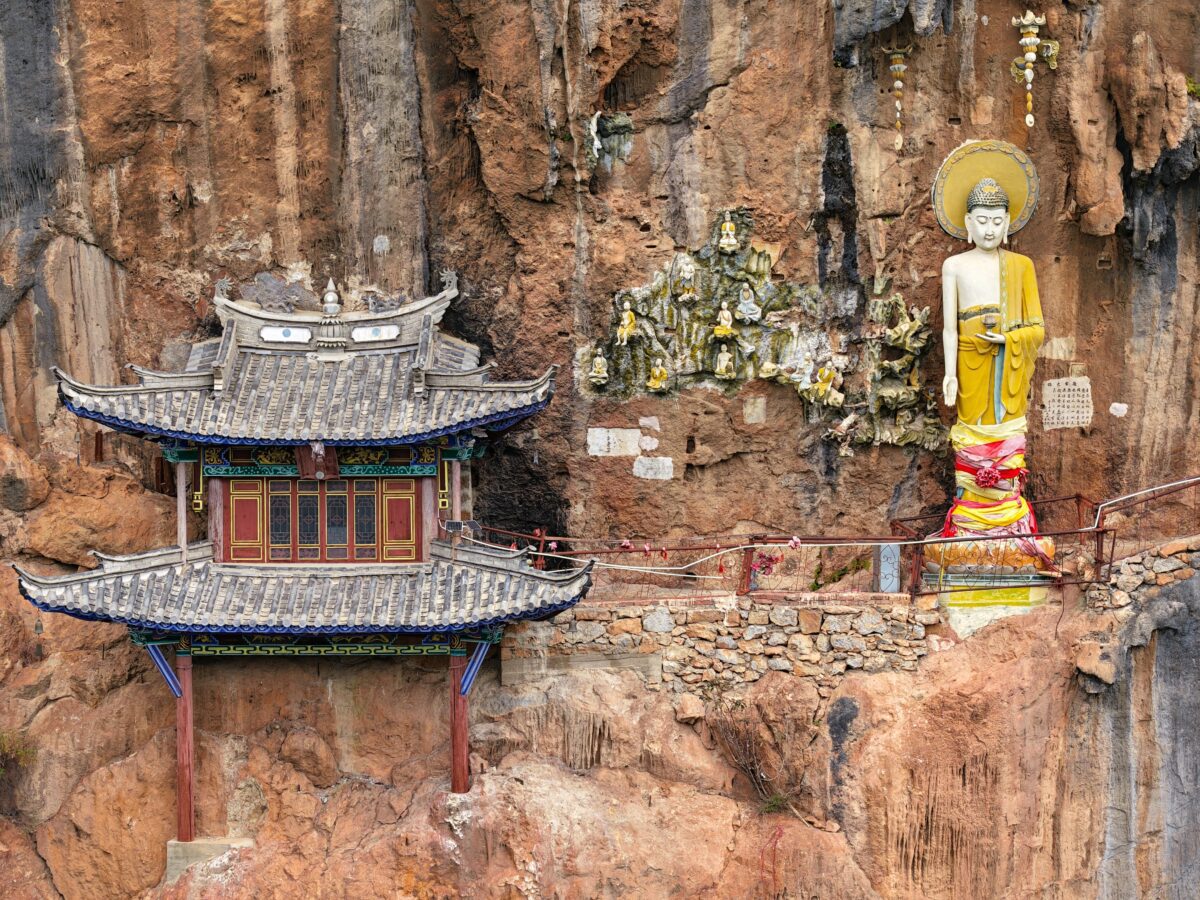
Hanging Temple in Dali, Yunnan quietly remains hidden from crowds that flock to the region’s major tourist destinations
When asking for sites to visit in Dali – a picturesque city just two hours northwest of Yunnan’s capital, Kunming – most tourists will instinctively head off to visit Dali’s most popular tourist attractions. The scenic surroundings engulfing Erhai Lake (洱海), the iconic Three Pagodas of Dali, and bustling Dali Old Town, a destination for experiencing the rich-Bai minority culture, usually dominate most people’s itineraries. However, I’m visiting a little-known destination on the quieter eastern side of Erhai Lake, the Hanging Temple in Dali.
Dali, which has gained a reputation as a slow-paced, hipster center in southwestern China, has witnessed a surge in commercialization. It’s yearly annual tourists continue to amplify, with 2023’s Spring Festival period seeing over 4.23 million people. Various Chinese social media platforms like Little Red Book (小红书) continue to push the slow-paced city as a prime travel destination. The Hanging Temple in Dali is somewhere most locals couldn’t even point in the direction of.
Looking to escape any flocks of people and eager to explore a peaceful, outdoor spot seeped in local culture, I order a Didi from my small hotel in Dali. Ten minutes later I’m headed an hour east of Dali, to the mountainous Cixiao Temple (慈孝寺), an area also includes the Hanging Temple in Dali (观音箐悬空寺).
Exploring Dali’s Hidden Temples
Upon arriving at the entrance of Cixiao Temple, I ask the driver, a local from the nearby city of Chuxiong (楚雄) if he has ever been to the Hanging Temple in Dali.
“Never stepped inside, nor seen the temple. It’s the first time I’ve actually seen this place,” he says as he parks his futuristic-looking Alto van up at the temple entrance’s massive red gates. A little concerned I’d be unable to locate a Didi driver later, I tapped on the driver’s window after grabbing my backpack.
“I’m headed to Shaxi (沙溪) after this hike. Can I book you for the whole afternoon?”
The young, energetic driver agrees, telling me he’ll charge his electric car up at a nearby charging station and be back in a couple hours. We exchange WeChat information and get on our ways.
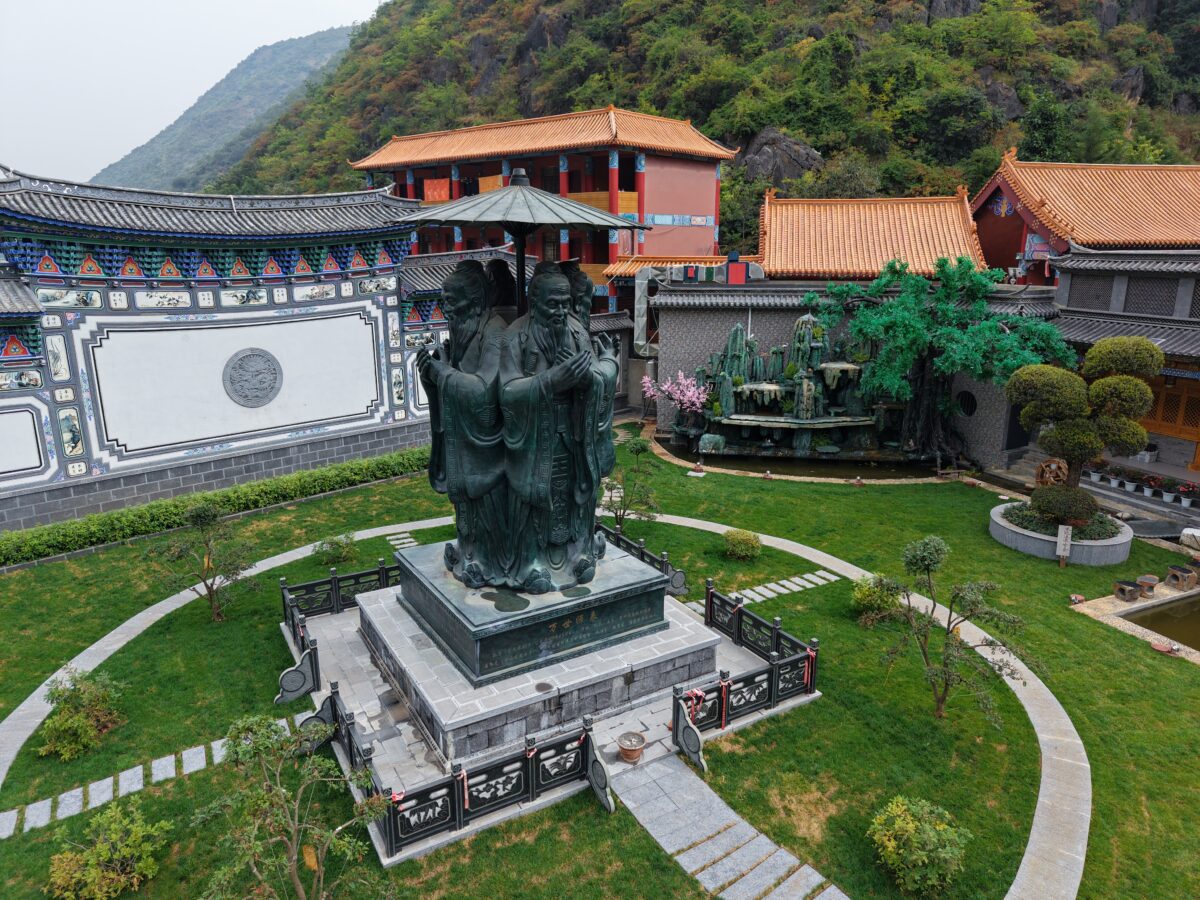
Gandering Around Cixiao Temple
Inscribed in a fancy Chinese script above the wooden gate entrance are the four characters “观景读书,” which translates to “reading while watching the scenery.” Opening the doors, visitors are welcomed to a massive four-facing dark teal statue of Kongzi, an array of green, perfectly trimmed gardens, and an assortment of uniquely-textured concrete walls. The tallest wall consists of a border of various Chinese paintings and roof decorations supported by various colorful tiles. I take a gander around the peaceful garden which interestingly has fertilized plants, with needles injected into the plants stem. At the same time, I take a step closer to read the characters on the base and to take a look at the Kongzi statue, which is surprisingly still well-kept.
Ready to get the hike going, I turn my head towards Jizu Mountain (鸡足山) in the distance. An ancient temple nestled along the base of the mountain appears. Higher up a Buddhist statue with the faint outline of Dali’s Hanging Temple, catches my eye.
A small prayer area and tourist center are right after the first set of entrance doors. There are zero tourists. Additionally there is no entrance fee. A discrete sign next to a plant to the side, along with a small decorative, traditional style entrance confirms I’m following the path towards Hanging Temple. Taking in the scenic surroundings along the path, I slowly make it to the next platform along the quiet mountainside.
Eventually, a fork appears with two sets of paths. To the left a small fountain area with a small assortment of Buddhist statues, and to the right, the path towards the mountaintop, as well as to Hanging Temple. Having just one Buddhist statue in mind, I head right. At nearly 2000 meters above sea level, I prepped myself for the multiple flights of steps that disappear into the mountains above.
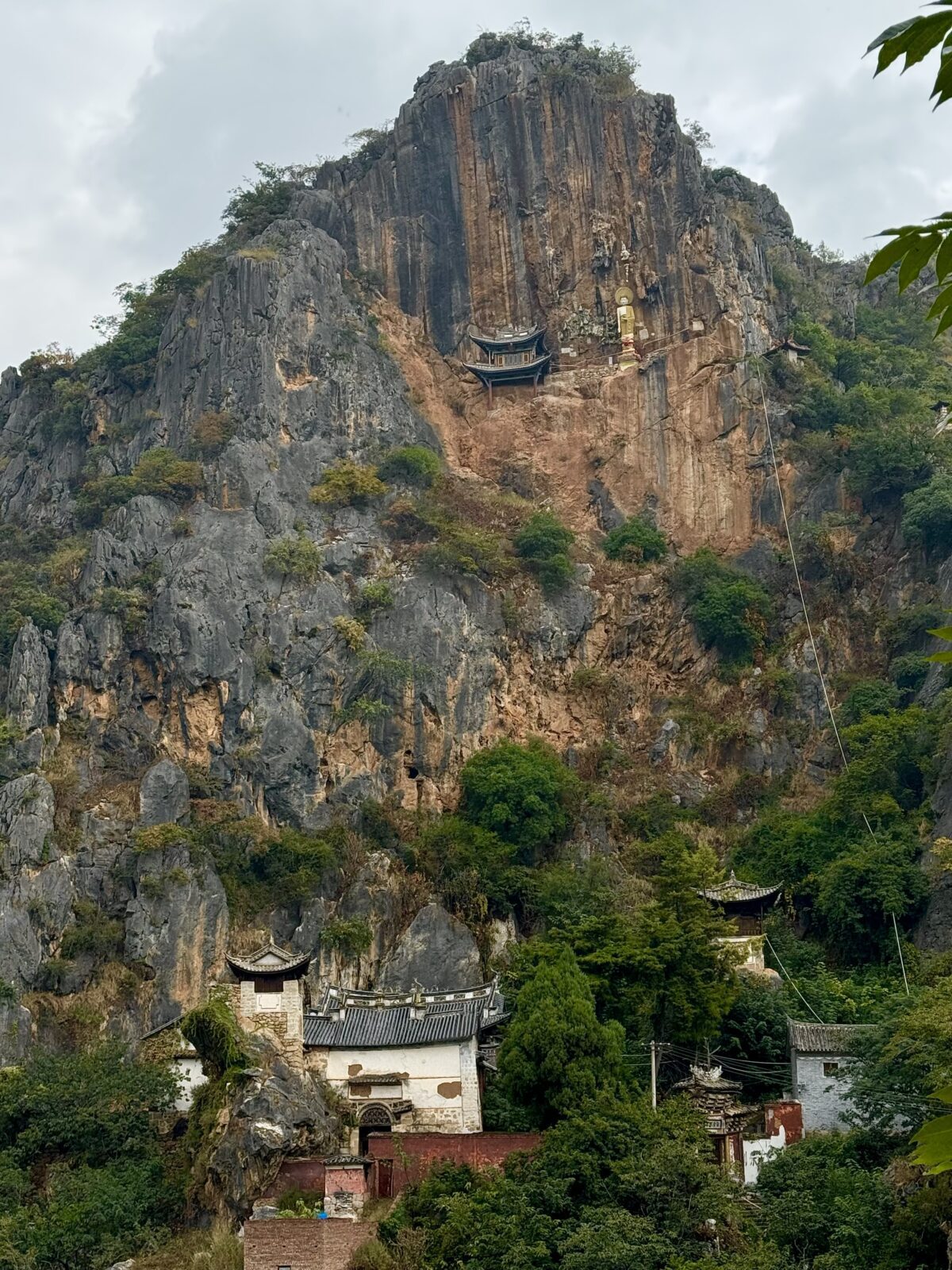
The slow ascent up is a slight workout, but the consistent view of the beautiful temples ahead makes the hike worth every bit. No handrails have been installed along the stairs, so it can feel a bit unsteady as you get up to some of the higher points. Hanging Temple still looks a ways away, but I keep telling myself the Buddhist statue seems to have gotten slightly larger.
The cool, fresh mountain air feels great as I reach the next platform with a small resting area. Noticing a few small buildings, I curiously walk up ahead. A dragon statue reaching forward from the back of a penniless, waterless fountain appears and becomes a quick rest stop. I grab a seat and ponder for a moment the meaning behind the unique pose.
Small wooden shacks and the sounds of goats bleating welcome you as you reach the third platform along the mountainside. A dirt road appears on the right, indicating there was a shorter path my driver could’ve taken me up. Gathering in my surroundings, I peek back at the stairs I’ve climbed. I take a swig from my now warm water bottle and march on towards Hanging Temple.
Jizu Mountain’s Secret Protectors
Red dirt and rocks beginning to form the surrounding around me, as I finally reach another set of stairs. Up ahead, a small garden appears with a variety of plants and shrubs, all sprouting up. The sounds of huffing and a metal tool hitting soft dirt suddenly come out of nowhere. Amidst a see of green, a monk in a traditional grey robe and pants is steadily working away at his garden as he hoes the ground. After watching him whack away for a few moments, he finally lets out a deep sigh, takes a short break, and catches me watching him. Slightly startled, he waves his hand, wipes down his forehead, and lifts up his pant legs as walks up.
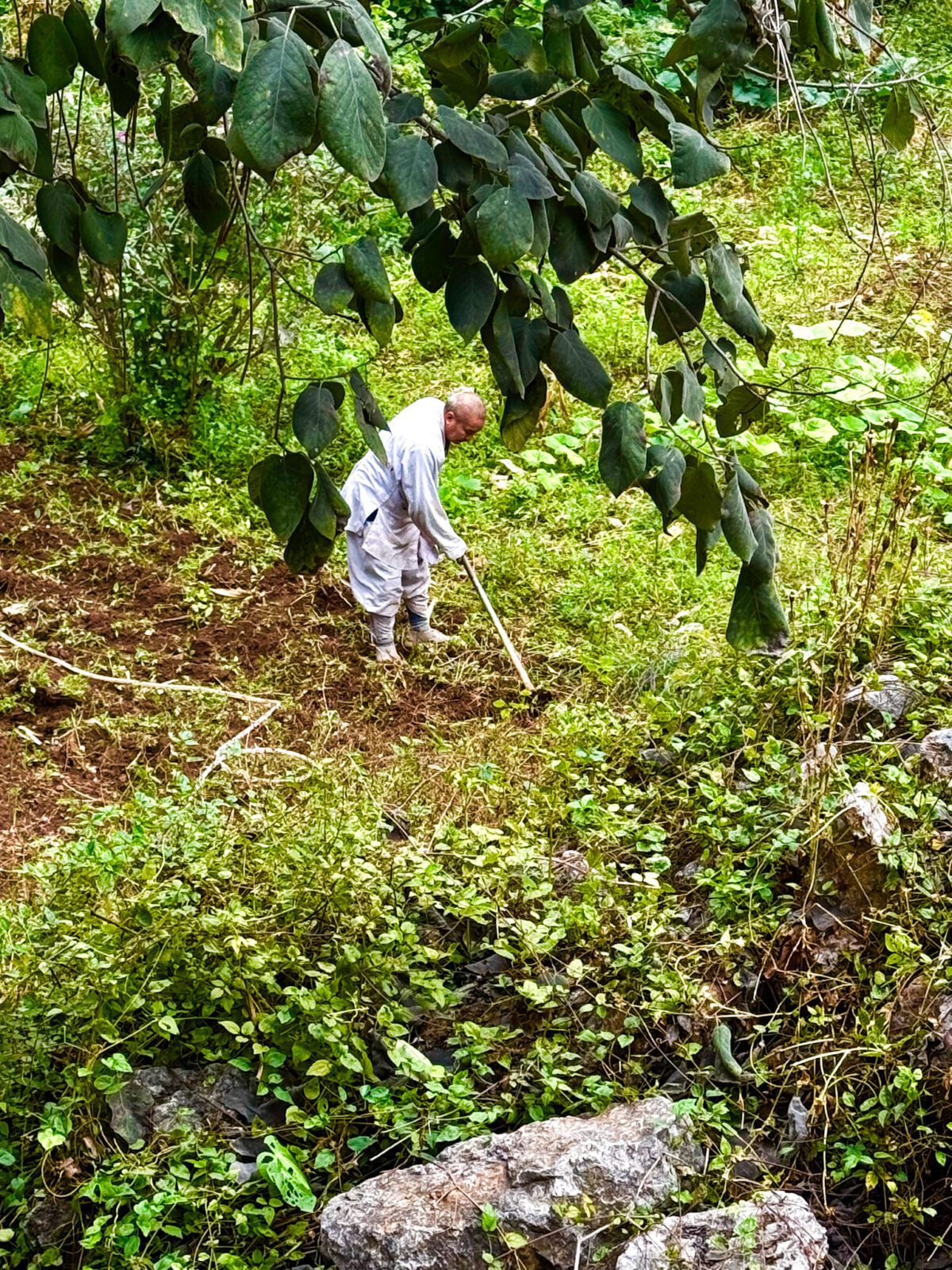
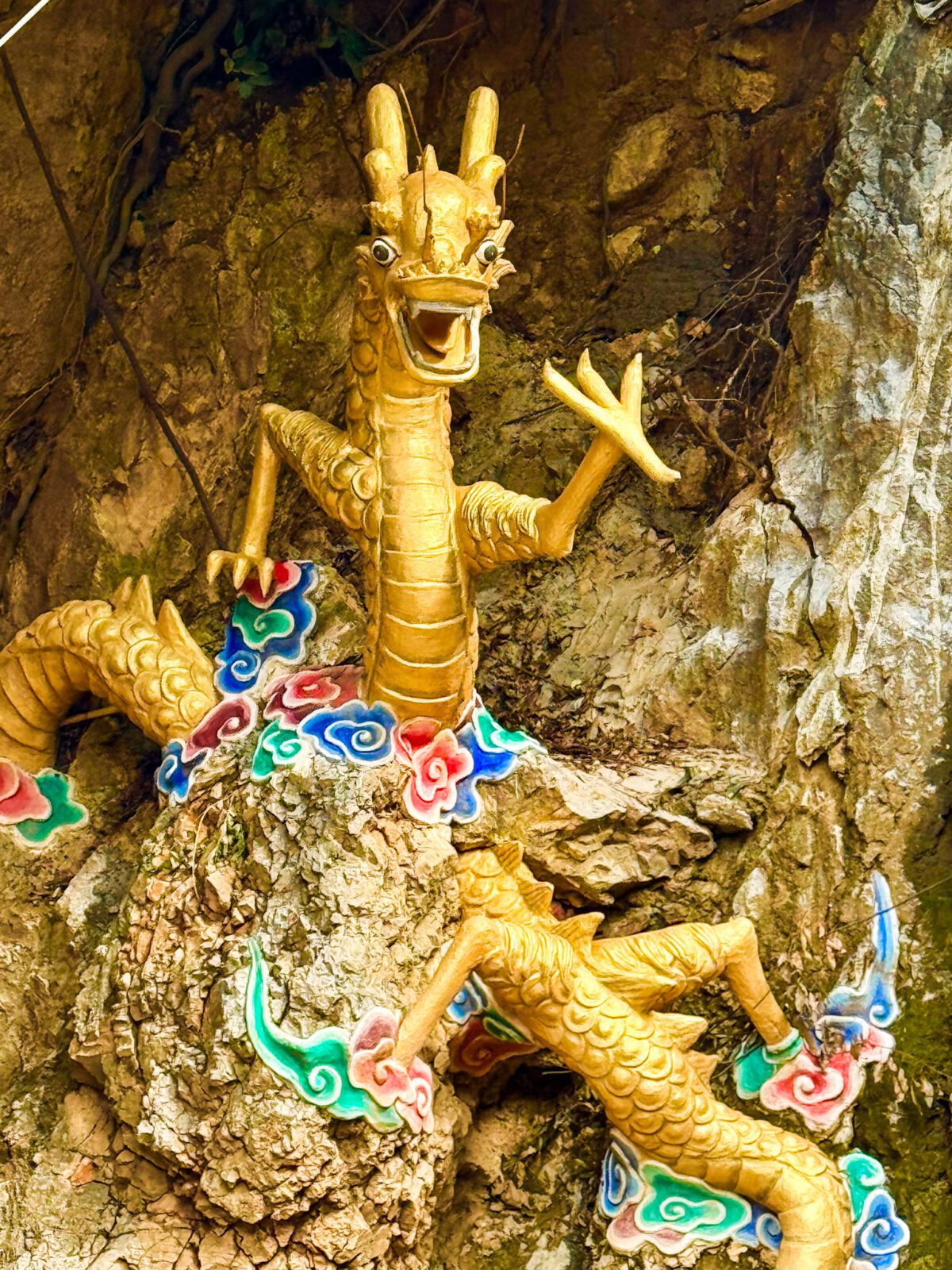
“Which way is the Hanging Temple?” I ask.
“Right up ahead. It’s not far. Just take the stone steps behind here and keep going up,” the exhausted monk says as he makes his way out of the garden.
The blue sky suddenly disappears. Looking above a gigantic banyan tree emerges with its endless roots dangling above. I walk closer to check out the massive beast which had to have been hundreds of years old, growing peacefully alongside Dali’s majestic Jizu Mountain. Behind the rocky mountains and curvy rock formations two winding paths emerge.
Left takes you to Guanyin Chan Temple (观音禅寺), where the monk is slowly making his way up towards. Going right is another stone step path that the monk had mentioned earlier leads to Dali’s Hanging Temple.
In no rush and ready to explore the area, I decide to tail behind the mysterious monk up towards his destination. An ancient stone tablet with intricate carvings of Chinese characters and emblems stands upright, while an array of stalagmite-looking rock formations jut out along the stone path. Ten minutes later, an ancient paifang (牌坊), a Chinese gate-like structure begins to appear from behind the curvy stone path with the characters “观音禅寺” appear above. I’ve arrived at Guanyin Chan Temple.
Living with Guanyin Chan Temple
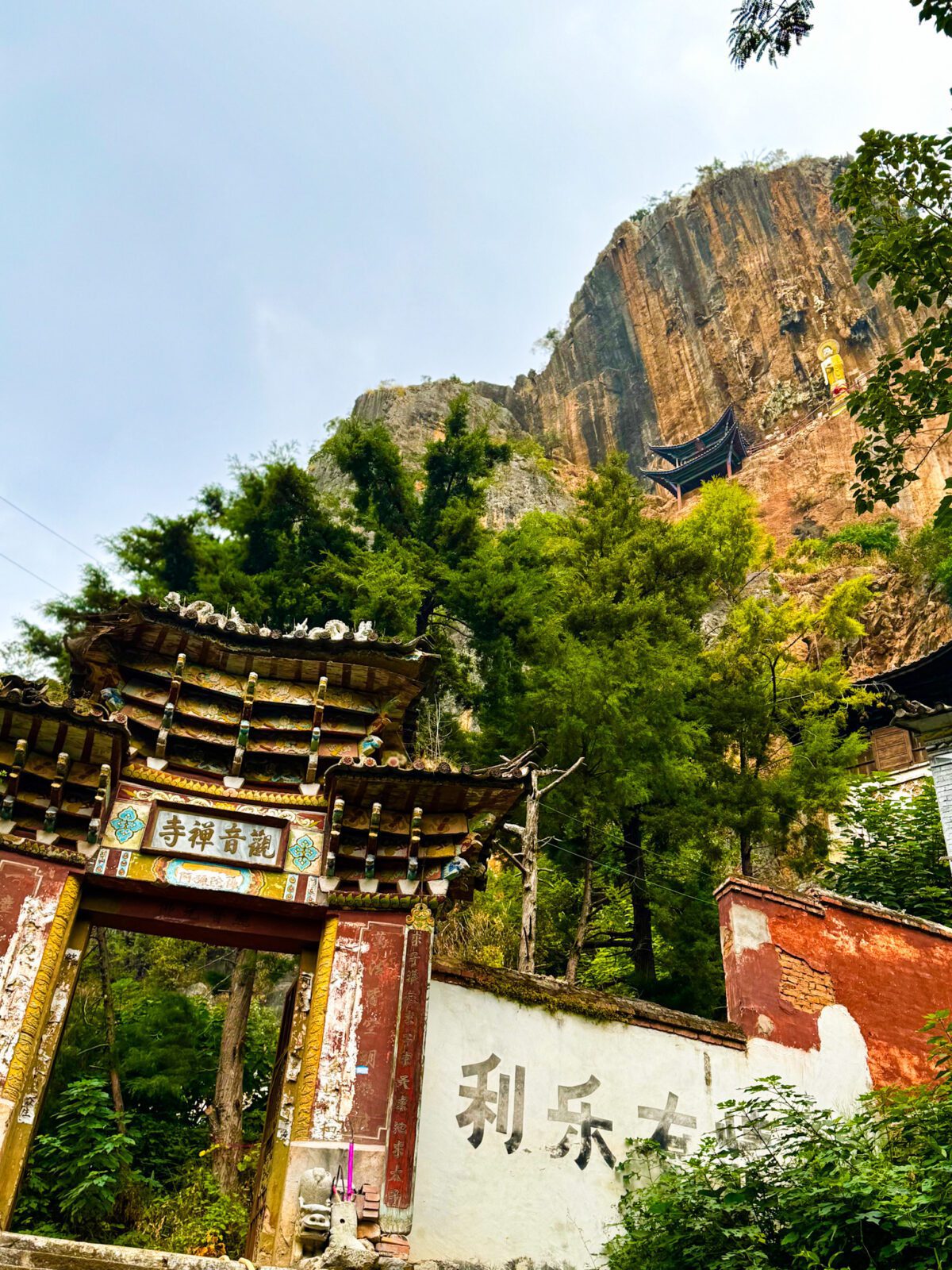
The entrance design is very intricate. A splendid array of colorful, wooden dragon heads point out in the same direction. There is still enough of the fading paint depicting ancient Chinese stories to make out the story-lines behind each painting. I especially enjoy looking at the half-dragon, half-lion like picture designed within the steel framed fence-gates.
Walking towards the main temple courtyard is a small, dark shrine with a statue of the God of Thunder (雷神) inside, who I greet and walk around. The mysterious monk working the garden suddenly reappears sitting at the entrance of a small, but surprisingly merchandise-less room. Instead of endless marked-up monk beads and jewelry, the grey room is packed with cushy sofas, cobweb-covered picture frames of previous monks who have visited, rectangle certifications from different visiting associations, and a simple tea table in the middle.
“How long have you been here?” I ask the sweat-drenched monk who is now busy preparing some warm tea.
“Close to twenty years. Came here and just stayed. Usually most monks stay at a location for three years and then are transferred to another location. Otherwise you have to get a new hukou (户口), ” the monk says as he points for me to try out some small chocolates on the tea table. A small sign in Chinese reads donations welcome. Hoping to have some good luck flow my way I drop in some spare cash I had in my pockets.
“What do you do for food? You’re so high up here,” I ask curiously.
“There’s only me and one other monk who live up here. We plant our own vegetables in the garden.”
I stroll about within the temple’s grounds looking at the different shrines hidden within. Located within are the both the Thunder God Shrine and the larger Prince’s Pavilion, where a Chinese warrior-like statue in golden armor stands with his hands fixated in a Buddhist mudra. Two red Chinese lanterns hang from both sides and two chiwen (鸱吻), mythical creatures that embody the shapes of dragon, fish, and owls, are fixated on the rooftop edges above. I found the rooftop decorations of Guanyin Chen Temple very fascinating, with a vast array of different creatures and figures I haven’t seen on other Chinese temple rooftops.
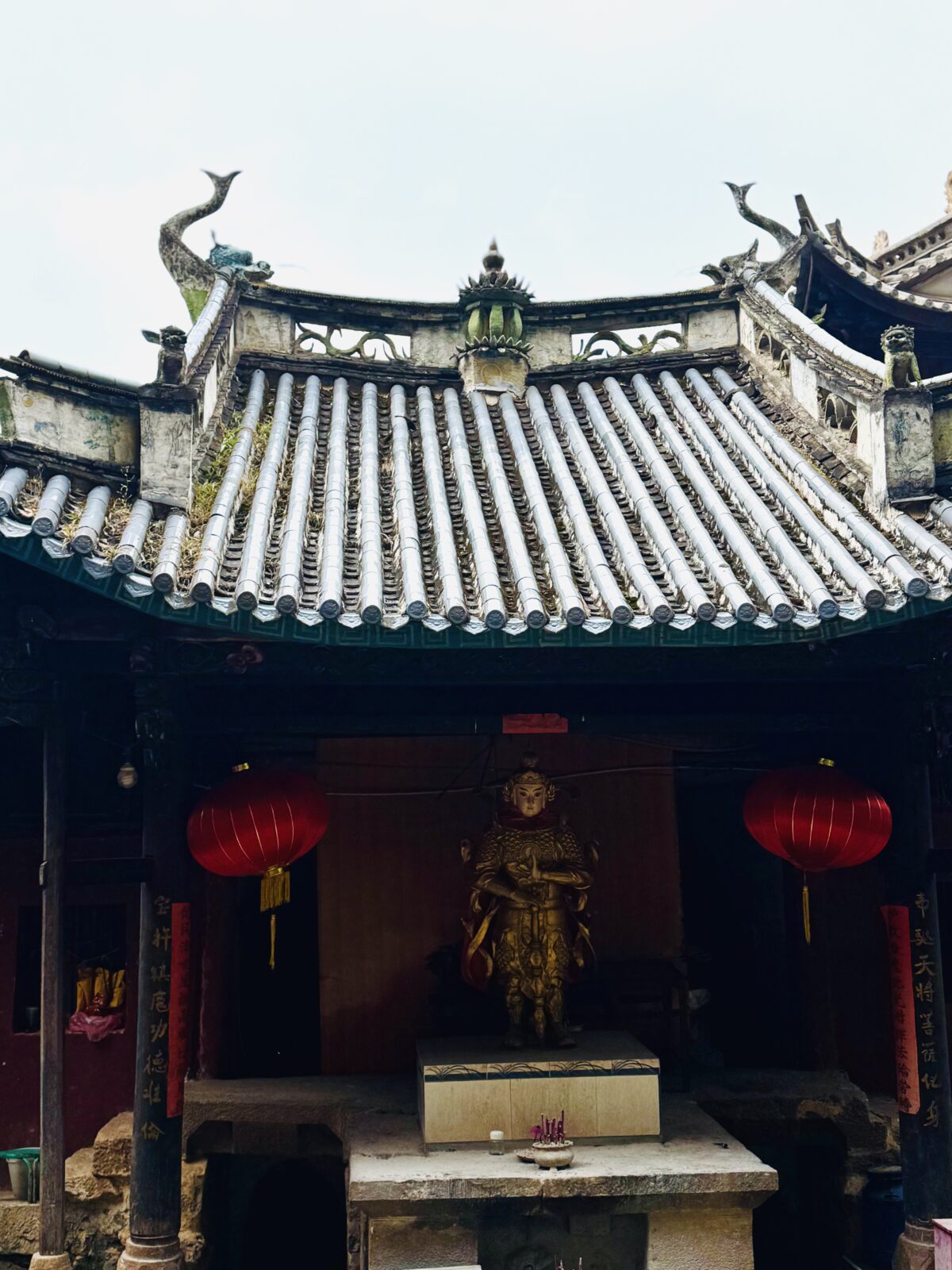
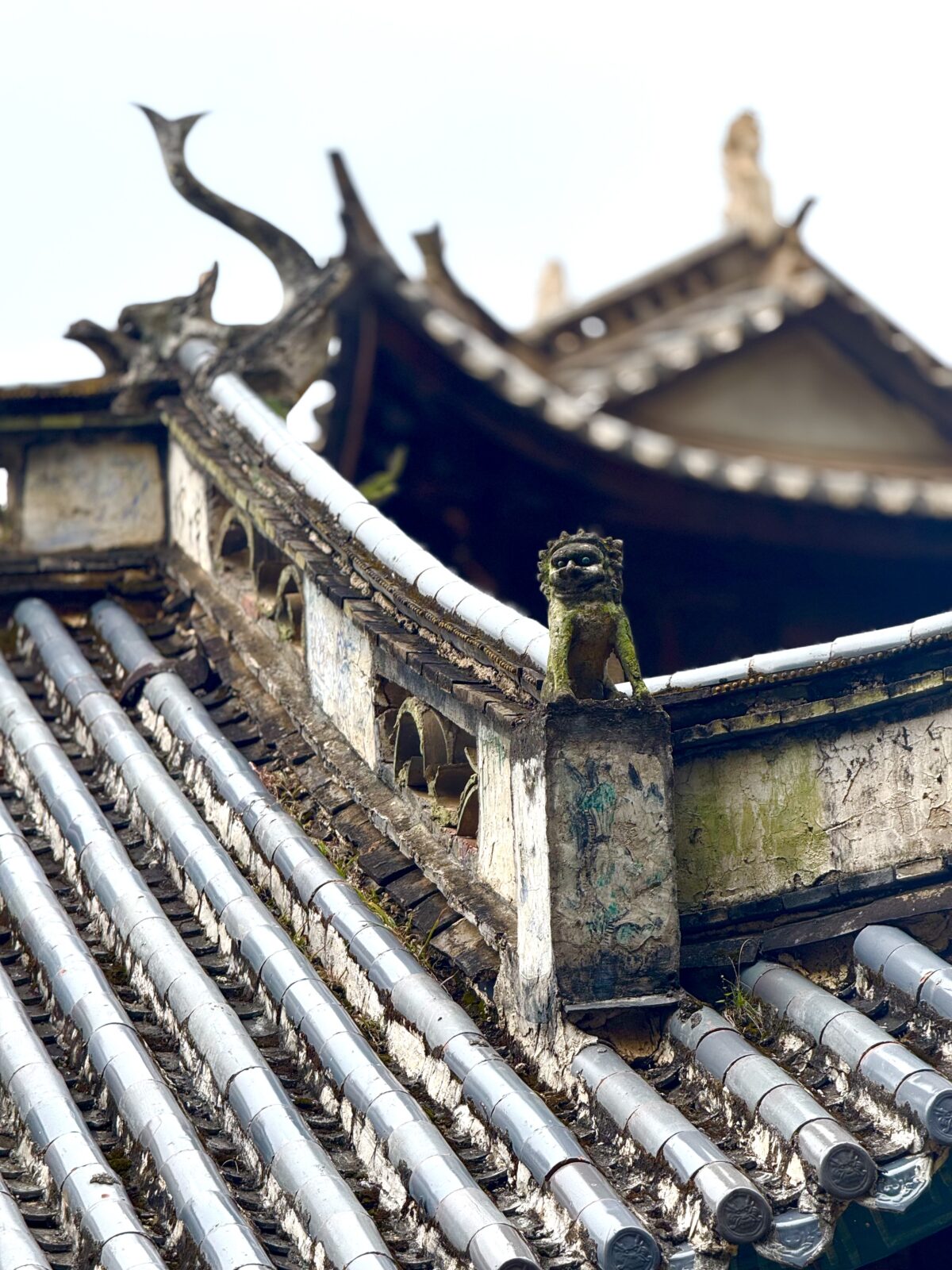
No definitive records of when Guanyin Chan Temple was constructed currently exist. The monk, happy to share the temple’s history with us, goes on to explain that Guanyin Chan Temple was damaged multiple times over the years. He starts off by sharing that Guanyin Chan Temple was first rebuilt by the Emperor Zhu Houxi during the Ming Dynasty (1368-1644) in 1529. Records on a stone tablet also mention Li Yuanyang, a local Bai minority official who may have directed the temple’s restoration project at the time. Later, the historical temple went through renovations during the reigns of Kangxi and Guangxu in the Qing Dynasty (1644-1911).
When the Cultural Revolution began in the 1960’s, Red Guards destroyed the upper portions of the temple. The monk shares renovations on those sections didn’t begin again till 1996, when more funding possibly became available. The final round of cumulative damages done to the temple occurred in 2012, when a small fire broke out in one of the attics. The attics were repaired much quicker this time, being restored two years later in 2014. Now, the temple seems finally, to able to exist in a safe, peaceful environment.
Seeing hardly any tourists along the hike, I ask the month about the area’s tourism pull. “So has it alway been this quiet? Do many tourists actually come here?”
The monk, legs crossed and quietly sipping on his tea answers. “Before Covid we could see twenty to thirty thousand people a year. Tourist numbers just haven’t really returned to those Pre-Pandemic numbers since.”
Floating Above with Hanging Temple in Dali
It begins to rain, but only a sprinkle. Having soaked up some of the temple’s history, I wave to the monk as I follow a small stone path to the side, back towards Hanging Temple. The stone slabs making up the steps are slightly slippery, but my North Face hiking shoes seem to do ok. Ten minutes into the hike another small traditional-Chinese style structure appears, with fresh graffiti and text plastered up on its exterior walls. Outside equipment makes the small structure seem like it ay have served as a ticket booth once. Wondering if the beautiful site will ever see that many tourists again, I wait the rain for fifteen minutes till I continue marching ahead.
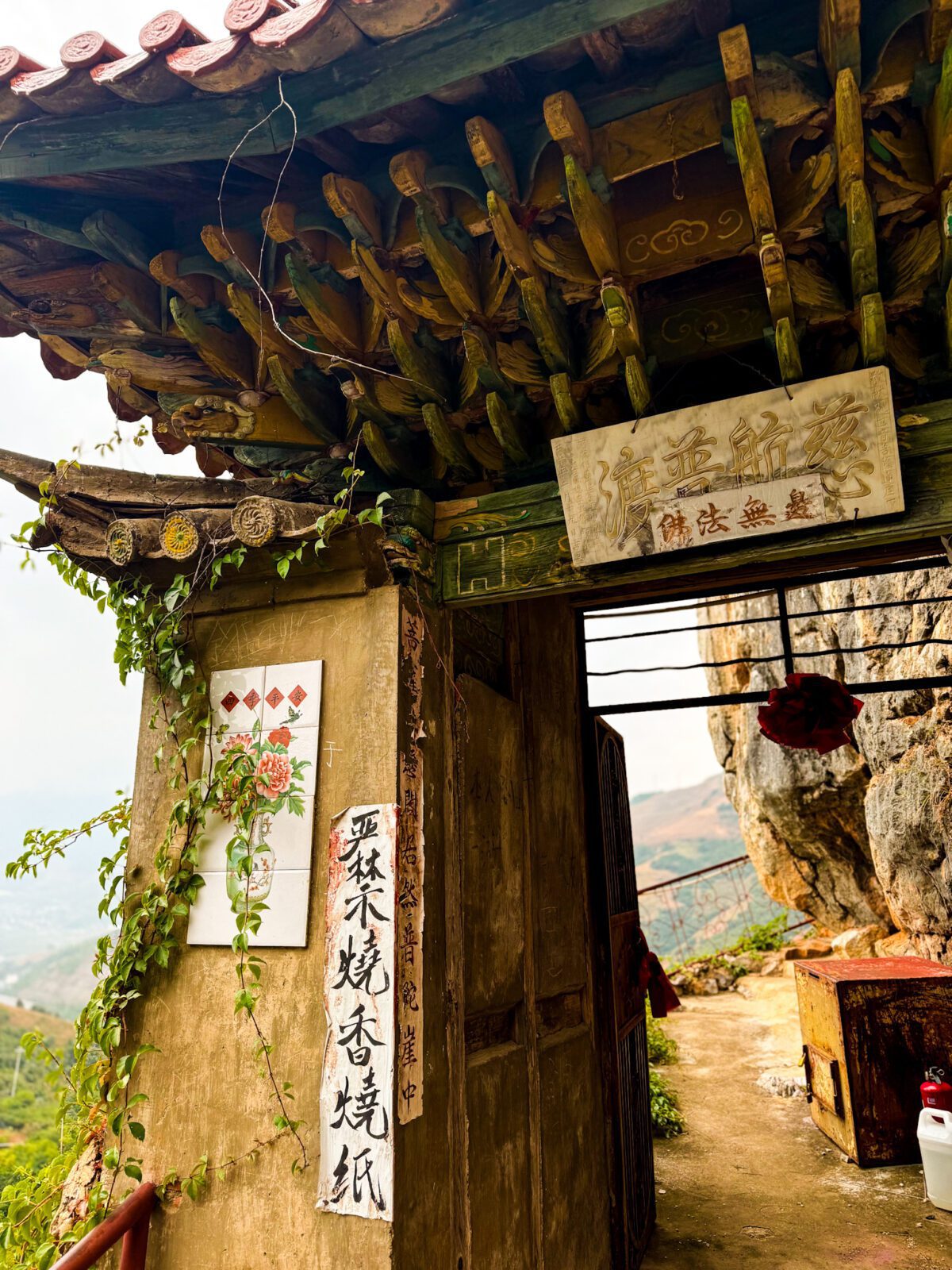
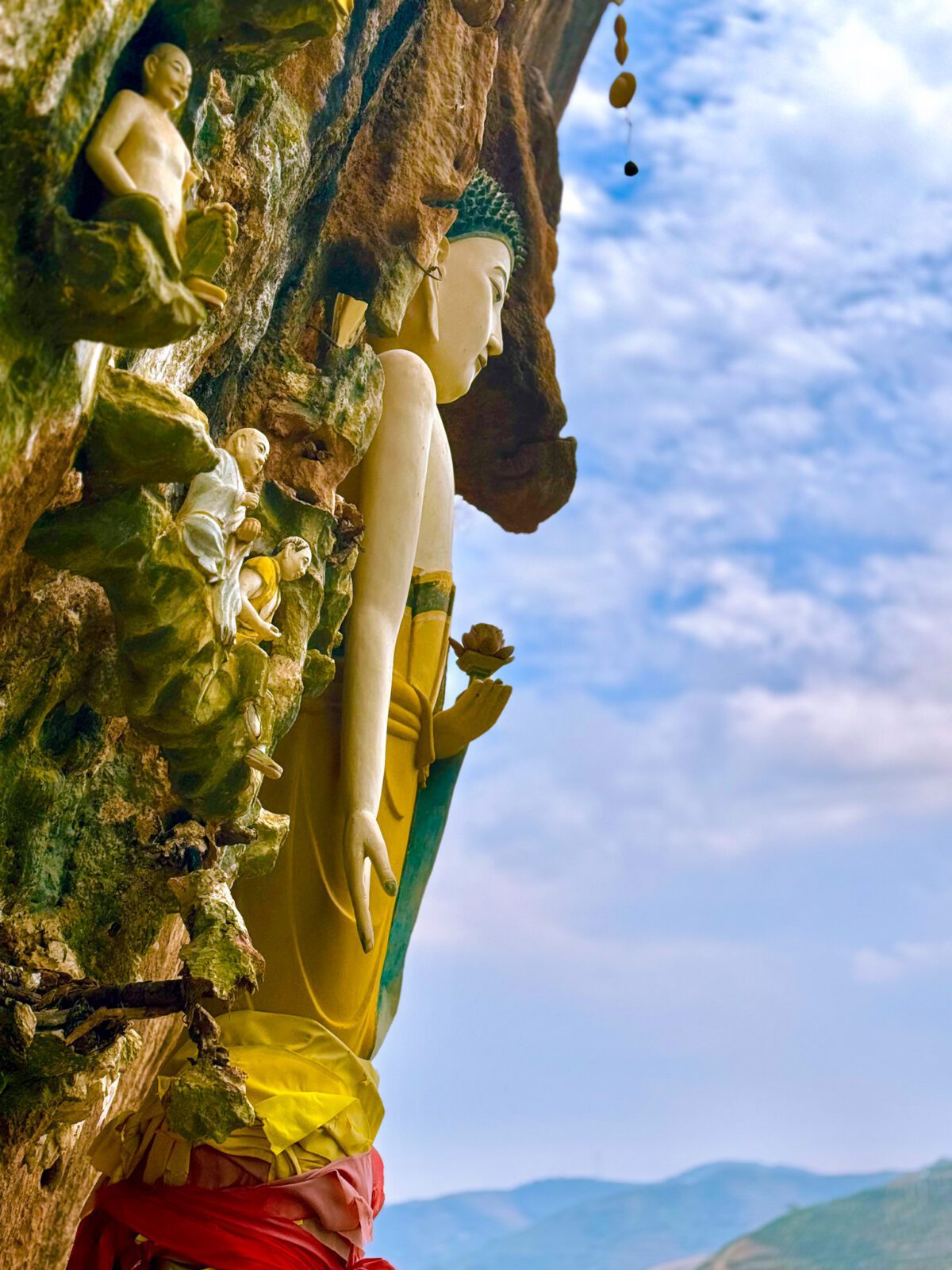
A young, dark-skinned worker trods down the path holding some equipment on his shoulder as we cross paths. Luckily, this higher section of the hike has more railings along the path. Following both the now dirt-like path and white electrical cords tucked around the square-frame railings like loose vines, I finally can start to make out the edge of the Hanging Temple. A few minutes later and another paifang, in the middle of having new roof tiles being added, appears before me. A classic Chinese flower vase tile design, colorful wooden dragon beams, and handwritten characters decorate the paifang’s rather grey, lifeless walls. Yellow-orange dragons and a gourd sit atop the entrance roof, adding a hint of excitement walking under the paifeng. I walk in, excited to experience clinging to life with the Hanging Temple.
Seeing the large, tilted Buddha temple is definitely breath-taking. With its feet wrapped in yellow and bright red ribbons that have weathered in the mountain breeze, and uneven rocky surface beneath your feet, you do feel like you need to walk carefully against the inner mountain wall. Leaning over the edge is a spectacular view of the mountain range and the now minuscule, Guanyin Chan Temple below.
Alongside the hanging Buddha are the 18 arhats, full of expressions, sitting atop small rocky ledges that look to have been chiseled out. Walking along the narrow pathway, you can really only appreciate everything from an angle. The small Hanging Temple is further down on the opposite side, slightly lower than the Buddha. I hop inside to see yet another small altar to pray and burn incense at.
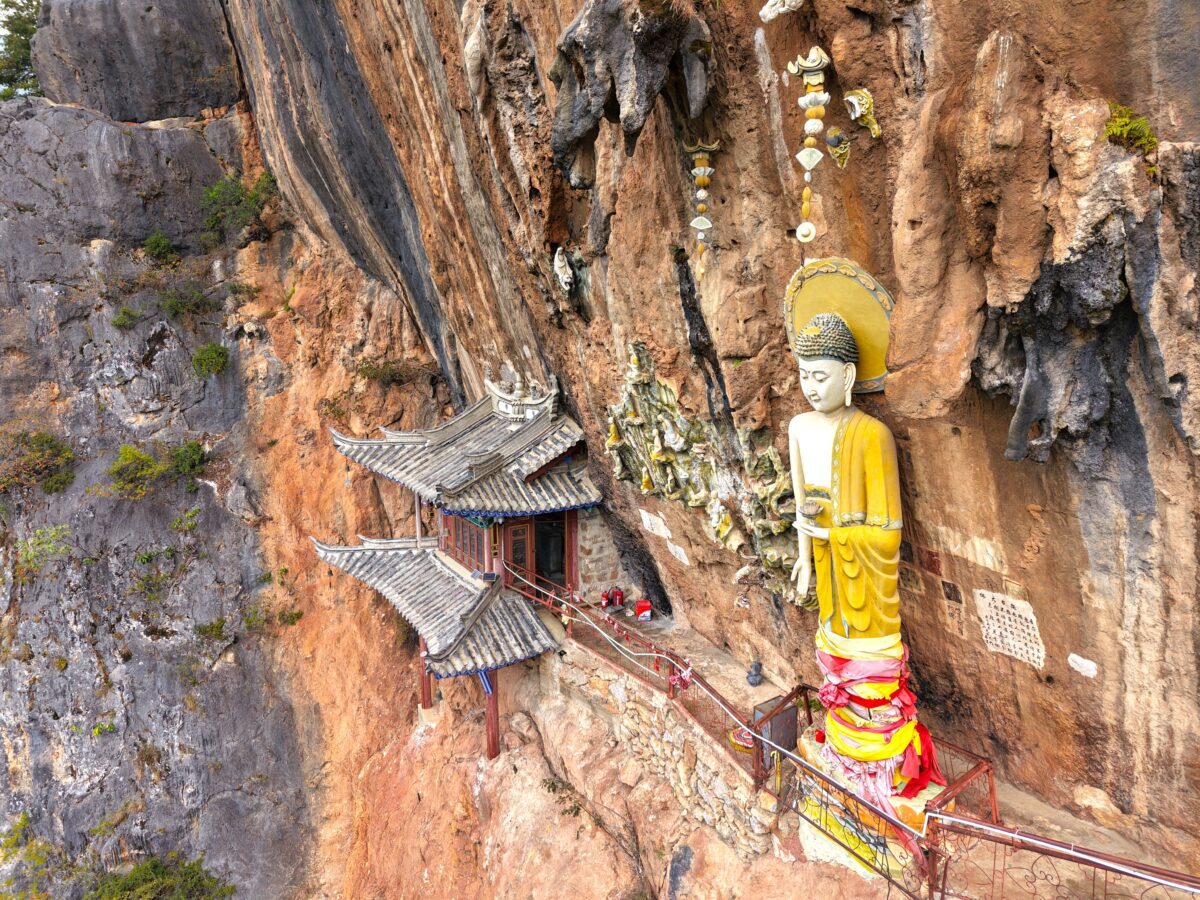
While the interior of Hanging Temple wasn’t as impressive as Guanyin Chen Temple, the size of the Buddha overseeing from such a towering altitude, the accompanying 18 arhats, and breathtaking views from atop Jizu Mountain, make Hanging Temple in Dali well worth the visit.
Maybe one day, the enchanting allure of Hanging Temple will be able to pull in the same number of tourists visiting Dali’s other major landmarks. Yet, inside I secretly hope the Hanging Temple in Dali will remain a hidden sanctuary, thriving quietly and preserving it’s untouched beauty.
Photography: Anson Zong-Liscum

